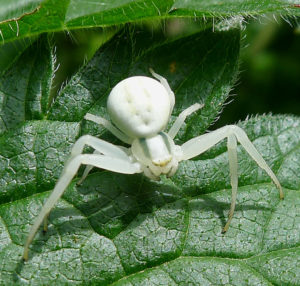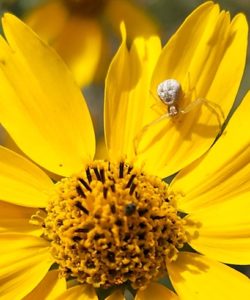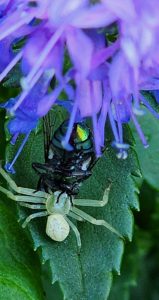February – Goldenrod Crab Spider
Scientific name: Misumena vatia
Common name: Goldenrod Crab Spider
Family: Thomisidae
Starting off our new blog for Invertebrate of the Month is the beautiful Goldenrod Crab Spider or Flower Spider, Misumena vatia, a member of the Thomisidae family. These spiders are named for their crab-like appearance and movements, including their ability to move sideways and backwards. Misumena vatia are typically found in areas with an abundance of flowers so it can practice its excellent hunting skills.

photo credit: gailhampshire
As the winter weather rages on in Santa Fe, each week I come across a different eight-legged critter taking refuge inside my home. If it’s really cold outside, I relocate them to the garage, but if it’s above freezing, I release them outside to find a more suitable shelter. Most spiders we encounter in our home, while unwanted, are harmless to people and pets.

Misumena vitia on Verbesina encelioides, Ojos y manos: Eyes and Hands Ethnobotanical Garden photo credit: Christie Collins
Goldenrod crab spiders are one of my favorite spiders to spot in a garden as they are masters of disguise. This spider can change color from white to yellow, matching the petals of flowers. This process is believed to be influenced by visual cues of the surrounding environment and can take several days to complete. This amazing adaptation makes them stealthy, effective hunters and invisible to predators.
Crab spiders catch their prey, typically an unsuspecting insect, by lying in wait for the opportune moment to grab their meal with their long front legs. Their anatomy makes them an ideal ambush hunter, with broad flat bodies and their front two pairs of legs being exceptionally longer and stronger than the back two. The adaptations of speed and camouflage replace the use of catching prey with a web.
Females of this species are usually larger than males, typically 5 to 10 mm long, with males measuring half that size. With the difference in size, mating can be especially dangerous for the males who can be overpowered by the females that mistake them for food.
After mating females lay eggs and guard them until the spiderlings emerge, approximately two weeks. The eggs are usually hidden by a folded over leaf stitched with silk by the female. Shortly after the eggs hatch the female dies.
Thankfully, Misumena vatia is not listed as endangered or vulnerable, however, like many invertebrates, they are susceptible to habitat destruction and the widespread use of pesticides, which can impact their populations and the broader ecosystem.
The Goldenrod Crab Spider has an important role to play in ecosystems as both predator and prey along with their contribution to the biodiversity of their habitats. Finding spiders in a garden indicates you have created a healthy habitat and should be welcomed as a useful resident.

Misumena that has caught a fly. Spotted in flower pot in front of Visitor Center. photo credit: Christie Collins


